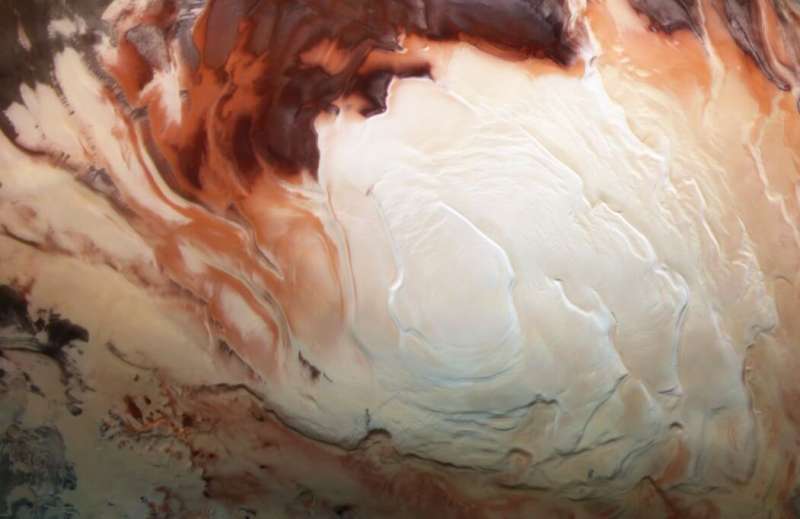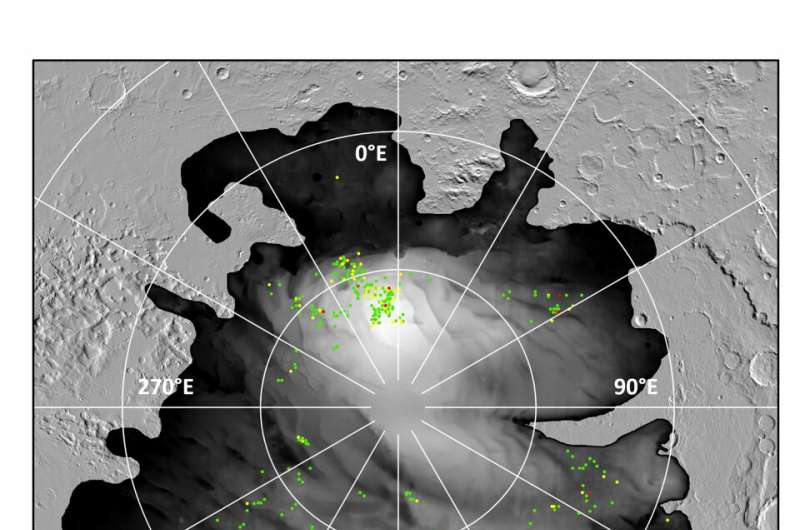Lakes' under Mars' south pole: A muddy picture?
- Get link
- X
- Other Apps
by Karin Valentine

Two research teams, using data from the European Space Agency's Mars Express orbiter, have recently published results suggesting that what were thought to be subsurface lakes on Mars may not really be lakes at all.
In 2018, scientists working with data from the Mars Express orbiter announced a surprising discovery: Signals from a radar instrument reflected off the red planet's south pole appeared to reveal a liquid subsurface lake. Several more such reflections have been announced since then.
In a new paper published in the American Geophysical Union's Geophysical Research Letters, lead author and graduate student Aditya Khuller of Arizona State University's School of Earth and Space Exploration with Jeffrey Plaut of NASA's Jet Propulsion Laboratory (JPL), describe finding dozens of similar radar reflections around the south pole after analyzing a broader set of Mars Express data. But many are in areas that should be too cold for water to remain liquid.
The question of whether the signals are liquid water or not is also being considered by a team of scientists led by ASU School of Earth and Space Exploration postdoctoral scholar Carver Bierson. Their research was also recently published in AGU's Geophysical Research Letters and determined that these bright reflections might be caused by subsurface clays, metal-bearing minerals or saline ice.
Mars Express is the second-longest-surviving continually active spacecraft in orbit around a planet other than Earth, behind only NASA's still-active 2001 Mars Odyssey. As Mars Express orbits Mars, it continues to provide important data on the red planet's subsurface, surface and atmosphere.
Onboard this spacecraft is an instrument called the Mars Advanced Radar for Subsurface and Ionosphere Sounding, or MARSIS for short. This instrument uses a radar sounder to assess the composition of the subsurface of Mars.
MARSIS has been collecting data around Mars since 2004, including the south pole, allowing scientists to build a three-dimensional view of the south polar region. "We wanted to look beneath the south polar ice and characterize the old terrain lying underneath using MARSIS data," said Khuller.
In other recent studies using MARSIS data, researchers have found areas where the reflections below the surface are brighter than that of the surface, which is not what scientists would expect.
"Usually, radar waves lose energy when they travel through a material, so reflections from deeper down should be less bright than those from the surface," said Khuller, who is concurrently on an internship at JPL under Plaut's direction. "Although there are a few possible reasons for unusually bright subsurface reflections, these two studies concluded that a liquid water component was the cause of these bright reflections, because liquid water appears bright to radar."

Frozen time capsule
The radar signals originally interpreted as liquid water were found in a region of Mars known as the South Polar Layered Deposits, named for the alternating layers of water ice, dry ice (frozen carbon dioxide) and dust that have settled there over millions of years. These layers are believed to hold a record of how the tilt in Mars' axis has shifted over time, just as changes in Earth's tilt have created ice ages and warmer periods throughout our planet's history. When Mars had a lower axial tilt, snowfall and layers of dust accumulated in the region and eventually formed the thick layered ice sheet found there today.
The areas originally hypothesized to contain liquid water span about 6 to 12 miles (10 to 20 kilometers) in a relatively small region of the Martian South Polar Layered Deposits. Khuller and Plaut expanded the search for similar strong radio signals to 44,000 measurements spread across 15 years of MARSIS data over the entirety of the Martian south polar region.
Unexpected 'lakes': A muddy picture?
The new, expanded study from Khuller and Plaut revealed dozens of additional bright radar reflections over a far greater range of area and depth than ever before. In some places, they were less than a mile from the surface, where temperatures are estimated to be minus 81 degrees Fahrenheit (minus 63 degrees Celsius)—so cold that water would be frozen, even if it contained salty minerals known as perchlorates, which can lower the freezing point of water.
"We're not certain whether these signals are liquid water or not, but they appear to be much more widespread than what the original paper found," said co-author Plaut, who is also the co-principal investigator of the orbiter's MARSIS instrument. "Either liquid water is common beneath Mars' south pole, or these signals are indicative of something else."
Additionally Khuller noted a 2019 paper in which researchers calculated the heat needed to melt subsurface ice in this region, finding that only recent volcanism under the surface could explain the potential presence of liquid water under the south pole.
"They found that it would take double the estimated Martian geothermal heat flow to keep this water liquid," Khuller said. "One possible way to get this amount of heat is through volcanism. However, we haven't really seen any strong evidence for recent volcanism at the south pole, so it seems unlikely that volcanic activity would allow subsurface liquid water to be present throughout this region."
Khuller and Plaut's next steps in this line of research are to investigate their discovery of a second, deeper layer under parts of the south pole of Mars, which scientists think represents an older buried terrain called the Dorsa Argentea Formation. It is thought to have been modified by ancient glaciers once present across the region, and they intend on trying to more accurately determine its composition and age.
Explore further
C. J. Bierson et al, Strong MARSIS Radar Reflections from the Base of Martian South Polar Cap may be due to Conductive Ice or Minerals, Geophysical Research Letters (2021). DOI: 10.1029/2021GL093880
Michael M. Sori et al, Water on Mars, With a Grain of Salt: Local Heat Anomalies Are Required for Basal Melting of Ice at the South Pole Today, Geophysical Research Letters (2019). DOI: 10.1029/2018GL080985

Goldilocks planets 'with a tilt' may develop more complex life
8 HOURS AGO

Early Earth was bombarded by series of city-sized asteroids
8 HOURS AGO

Scientists learn how otters stay hotter
9 HOURS AGO

Meet the open-source software powering NASA's Ingenuity Mars Helicopter
10 HOURS AGO

Curiosity rover finds patches of rock record erased, revealing clues
10 HOURS AGO

The pressure is off and high temperature superconductivity remains
10 HOURS AGO

Unlocking radiation-free quantum technology with graphene
10 HOURS AGO
Relevant PhysicsForums posts
A problem with science media coverage
5 HOURS AGO
Is time a consequence of 2nd law of thermodynamics?
JUL 07, 2021
Solar panel effectiveness
JUL 05, 2021
Solving the heat equation numerically using Python
JUL 05, 2021
More from Other Physics Topics
Comments
Post a Comment